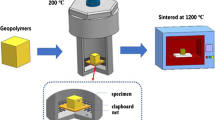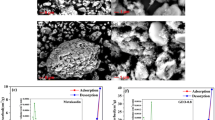Abstract
A basic investigation into whether a geopolymer can be utilized as a part of an artificial barrier during radioactive waste disposal was conducted in this study. Geopolymers are comprised primarily alumina and silica, and they exhibit negligible leaching owing to the absence of calcium. Studies on geopolymers are limited compared to those on other cementitious materials because the physical characteristics of geopolymers vary with the production conditions. In this work, metakaolin based geopolymers were prepared, and their diffusion performance was analyzed. The results indicate that the diffusivity of cesium in a geopolymer is affected by the type of alkali activator. Sodium-activated geopolymers had higher cesium adsorption capacity than potassium-activated geopolymers. The cesium adsorption capacity also had a significant effect on the diffusivity of cesium in the geopolymers. It was shown that, in addition to the pore structure and surface area, the mobility of water affects the diffusion performance of the geopolymer.










Similar content being viewed by others
References
Kurumisawa K, Haga K, Hayashi D, Owada H (2016) Effects of calcium leaching on diffusion properties of hardened and altered cement pastes. Phys Chem Earth 99:175–183. https://doi.org/10.1016/j.pce.2017.03.007
Joseph Davidovits (2008) Geopolymer Chemistry and Applications
Provis JL (2018) Alkali-activated materials. Cem Concr Res 114:40–48. https://doi.org/10.1016/j.cemconres.2017.02.009
Duxson P, Fernández-Jiménez A, Provis JL et al (2007) Geopolymer technology: the current state of the art. J Mater Sci 42:2917–2933. https://doi.org/10.1007/s10853-006-0637-z
Palacios M, Puertas F, Banfill PFG (2007) Rheological Behaviour of Alkali-Activated Slag Pastes and Mortars. Effect of Admixtures. 12th ICCC, Montr Canada 80
Gharzouni A, Joussein E, Samet B et al (2015) Effect of the reactivity of alkaline solution and metakaolin on geopolymer formation. J Non Cryst Solids 410:127–134. https://doi.org/10.1016/j.jnoncrysol.2014.12.021
Duxson P, Mallicoat SW, Lukey GC et al (2007) The effect of alkali and Si/Al ratio on the development of mechanical properties of metakaolin-based geopolymers. Collo Surf A Physicochem Eng Asp 292:8–20. https://doi.org/10.1016/j.colsurfa.2006.05.044
Duxson P, Provis JL, Lukey GC, et al. (2005). Understanding the relationship between geopolymer composition, microstructure and mechanical properties. 269 47–58. https://doi.org/10.1016/j.colsurfa.2005.06.060
Duxson P, Lukey GC, Separovic F, Deventer JSJ Van (2005) Effect of Alkali Cations on Aluminum Incorporation in Geopolymeric Gels. 832–839. https://doi.org/10.1021/ie0494216
Rovnaník P (2010) Effect of curing temperature on the development of hard structure of metakaolin-based geopolymer. Constr Build Mater 24:1176–1183. https://doi.org/10.1016/j.conbuildmat.2009.12.023
Muñiz-Villarreal MS, Manzano-Ramírez A, Sampieri-Bulbarela S et al (2011) The effect of temperature on the geopolymerization process of a metakaolin-based geopolymer. Mater Lett 65:995–998. https://doi.org/10.1016/j.matlet.2010.12.049
Mo BH, Zhu H, Cui XM et al (2014) Effect of curing temperature on geopolymerization of metakaolin-based geopolymers. Appl Clay Sci 99:144–148. https://doi.org/10.1016/j.clay.2014.06.024
Aredes FGM, Campos TMB, MacHado JPB et al (2015) Effect of cure temperature on the formation of metakaolinite-based geopolymer. Ceram Int 41:7302–7311. https://doi.org/10.1016/j.ceramint.2015.02.022
Sasaki K, Kurumisawa K, Ibayashi K (2019) Effect of retarders on flow and strength development of alkali-activated fly ash/blast furnace slag composite. Constr Build Mater 216:337–346. https://doi.org/10.1016/j.conbuildmat.2019.05.022
Benavent V, Frizon F, Poulesquen A (2016) Effect of composition and aging on the porous structure of metakaolin-based geopolymers. J Appl Crystallogr 49:2116–2128. https://doi.org/10.1107/S1600576716014618
Pouhet R, Cyr M, Bucher R (2019) Influence of the initial water content in flash calcined metakaolin-based geopolymer. Constr Build Mater 201:421–429. https://doi.org/10.1016/j.conbuildmat.2018.12.201
Rouyer J, Benavent V, Frizon F, Poulesquen A (2017) Influence of geopolymer formulation parameters on the elastic and porous properties over a one-year monitoring. Mater Lett 207:121–124. https://doi.org/10.1016/j.matlet.2017.06.125
Tennakoon C, Shayan A, Sanjayan JG, Xu A (2017) Chloride ingress and steel corrosion in geopolymer concrete based on long term tests. Mater Des 116:287–299. https://doi.org/10.1016/j.matdes.2016.12.030
Yang T, Yao X, Zhang Z (2014) Quantification of chloride diffusion in fly ash-slag-based geopolymers by X-ray fluorescence (XRF). Constr Build Mater 69:109–115. https://doi.org/10.1016/j.conbuildmat.2014.07.031
Osio-Norgaard J, Gevaudan JP, Srubar WV (2018) A review of chloride transport in alkali-activated cement paste, mortar, and concrete. Constr Build Mater 186:191–206. https://doi.org/10.1016/J.CONBUILDMAT.2018.07.119
Jang JG, Park SM, Lee HK (2016) Physical barrier effect of geopolymeric waste form on diffusivity of cesium and strontium. J Hazard Mater 318:339–346. https://doi.org/10.1016/j.jhazmat.2016.07.003
Bondar D, Ma Q, Soutsos M et al (2018) Alkali activated slag concretes designed for a desired slump, strength and chloride diffusivity. Constr Build Mater 190:191–199. https://doi.org/10.1016/j.conbuildmat.2018.09.124
Bernal SA, Mejía De Gutiérrez R, Provis JL (2012) Engineering and durability properties of concretes based on alkali-activated granulated blast furnace slag/metakaolin blends. Constr Build Mater 33:99–108. https://doi.org/10.1016/j.conbuildmat.2012.01.017
Lloyd RR, Provis JL, Van Deventer JSJ (2010) Pore solution composition and alkali diffusion in inorganic polymer cement. Cem Concr Res 40:1386–1392. https://doi.org/10.1016/j.cemconres.2010.04.008
Kuenzel C, Cisneros JF, Neville TP et al (2015) Encapsulation of Cs/Sr contaminated clinoptilolite in geopolymers produced from metakaolin. J Nucl Mater 466:94–99. https://doi.org/10.1016/j.jnucmat.2015.07.034
Arbel Haddad M, Ofer-Rozovsky E, Bar-Nes G et al (2017) Formation of zeolites in metakaolin-based geopolymers and their potential application for cs immobilization. J Nucl Mater 493:168–179. https://doi.org/10.1016/j.jnucmat.2017.05.046
Berger S, F. Frizon, Fournel V, Cau-dit-Coumes C (2007) Immobilization of Cesium in Geopolymeric Matrix: a formulation study. 12th Int Congr Chem Cem 1–11
Amorim Júnior NS, Andrade Neto JS, Santana HA et al (2021) Durability and service life analysis of metakaolin-based geopolymer concretes with respect to chloride penetration using chloride migration test and corrosion potential. Constr Build Mater. https://doi.org/10.1016/j.conbuildmat.2021.122970
Noushini A, Nguyen QD, Castel A (2021) Assessing alkali-activated concrete performance in chloride environments using NT Build 492. Mater Struct Constr 54:1–15. https://doi.org/10.1617/s11527-021-01652-7
Gluth GJG, Arbi K, Bernal SA et al (2020) RILEM TC 247-DTA round robin test: carbonation and chloride penetration testing of alkali-activated concretes. Mater Struct Constr 53:1–17. https://doi.org/10.1617/s11527-020-1449-3
Fu C, Ye H, Zhu K et al (2020) Alkali cation effects on chloride binding of alkali-activated fly ash and metakaolin geopolymers. Cem Concr Compos 114:103721. https://doi.org/10.1016/j.cemconcomp.2020.103721
Benavent V, Steins P, Sobrados I et al (2016) Impact of aluminum on the structure of geopolymers from the early stages to consolidated material. Cem Concr Res 90:27–35. https://doi.org/10.1016/j.cemconres.2016.09.009
Mortlock RF, Bell AT, Radke CJ (1991) NMR investigations of tetrapropylammonium aluminosilicate and borosilicate solutions. J Phys Chem 95:372–378. https://doi.org/10.1021/j100154a067
Massiot D, Fayon F, Capron M et al (2002) Modelling one- and two-dimensional solid-state NMR spectra. Magn Reson Chem 40:70–76. https://doi.org/10.1002/mrc.984
Duxson P, Lukey GC, van Deventer JSJ (2006) Thermal evolution of metakaolin geopolymers: Part 1 - Physical evolution. J Non Cryst Solids 352:5541–5555. https://doi.org/10.1016/j.jnoncrysol.2006.09.019
Muller ACA, Scrivener KL, Gajewicz AM, McDonald PJ (2013) Use of bench-top NMR to measure the density, composition and desorption isotherm of C-S-H in cement paste. Microporous Mesoporous Mater 178:99–103. https://doi.org/10.1016/j.micromeso.2013.01.032
Scrivener K, Snellings R, Lothenbach B (2016) A Practical Guide to Microstructural Analysis of Cementitious Materials
Kurumisawa K, Jensen OM (2020) Thermoporometry and proton NMR measurement on cement paste equilibrated at different relative humidities. J Adv Concr Technol. https://doi.org/10.3151/jact.18.456
Kurumisawa K (2015) Application of thermoporometry for evaluation of properties of hardened cement paste. Constr Build Mater 101:926–931. https://doi.org/10.1016/j.conbuildmat.2015.10.061
Hou D, Zhang J, Pan W et al (2020) Nanoscale mechanism of ions immobilized by the geopolymer: A molecular dynamics study. J Nucl Mater 528:151841. https://doi.org/10.1016/j.jnucmat.2019.151841
Nokken M, Boddy A, Hooton RD, Thomas MDA (2006) Time dependent diffusion in concrete-three laboratory studies. Cem Concr Res 36:200–207. https://doi.org/10.1016/j.cemconres.2004.03.030
Luping T, Gulikers J (2007) On the mathematics of time-dependent apparent chloride diffusion coefficient in concrete. Cem Concr Res 37:589–595. https://doi.org/10.1016/j.cemconres.2007.01.006
Tian Q, Nakama S, Sasaki K (2019) Immobilization of cesium in fly ash-silica fume based geopolymers with different Si/Al molar ratios. Sci Total Environ 687:1127–1137. https://doi.org/10.1016/j.scitotenv.2019.06.095
Jaya NA, Yun-Ming L, Cheng-Yong H et al (2020) Correlation between pore structure, compressive strength and thermal conductivity of porous metakaolin geopolymer. Constr Build Mater 247:118641. https://doi.org/10.1016/j.conbuildmat.2020.118641
Kubba Z, Fahim Huseien G, Sam ARM et al (2018) Impact of curing temperatures and alkaline activators on compressive strength and porosity of ternary blended geopolymer mortars. Case Stud Constr Mater 9:e00205. https://doi.org/10.1016/j.cscm.2018.e00205
Lippmaa E, Mági M, Samoson A et al (1981) Investigation of the Structure of Zeolites by Solid-State High-Resolution 29Si NMR Spectroscopy. J Am Chem Soc 103:4992–4996. https://doi.org/10.1021/ja00407a002
Brun M, Lallemand A, Quinson J-F, Eyraud C (1977) A new method for the simultaneous determination of the size and shape of pores: the thermoporometry. Thermochim Acta 21:59–88. https://doi.org/10.1016/0040-6031(77)85122-8
Snyder KA, Bentz DP (2004) Suspended hydration and loss of freezable water in cement pastes exposed to 90% relative humidity. Cem Concr Res 34:2045–2056. https://doi.org/10.1016/j.cemconres.2004.03.007
Kurumisawa K, Mami Ojima (2020) Physical properties and Microstructure of metakaolin based geopolymer. In: Proceedings of the ConMat’20, Advances in Construction Materials. Fukuoka, pp 413–422
Bentz DP, Snyder KA, Cass LC, Peltz MA (2008) Doubling the service life of concrete structures. I: reducing ion mobility using nanoscale viscosity modifiers. Cem Concr Compos 30:674–678. https://doi.org/10.1016/j.cemconcomp.2008.05.001
Acknowledgements
This work was supported in part by the Ministry of Economy, Trade and Industry (METI). A part of this work was conducted at the Joint-use Facilities: Laboratory of Nano-Micro Material Analysis, Hokkaido University, supported by the "Nanotechnology Platform” program of the Ministry of Education, Culture, Sports, Science and Technology (MEXT), Japan. We express our gratitude to these sources.
Author information
Authors and Affiliations
Contributions
Kiyofumi Kurumisawa
Supervision, Conceptualization, Methodology, Writing- Original draft preparation, Writing- Editing. Hiroaki Ohmatsu: Methodology. Yuta Yamashina
Methodology.
The authors declare that they have no known competing financial interests or personal relationships that could have appeared to influence the work reported in this paper.
Corresponding author
Ethics declarations
Conflict of interest
The authors declare no conflict of interest.
Additional information
Publisher's Note
Springer Nature remains neutral with regard to jurisdictional claims in published maps and institutional affiliations.
Supplementary Information
Below is the link to the electronic supplementary material.
Rights and permissions
About this article
Cite this article
Kurumisawa, K., Omatu, H. & Yamashina, Y. Effect of alkali activators on diffusivity of metakaolin-based geopolymers. Mater Struct 54, 169 (2021). https://doi.org/10.1617/s11527-021-01758-y
Received:
Accepted:
Published:
DOI: https://doi.org/10.1617/s11527-021-01758-y




